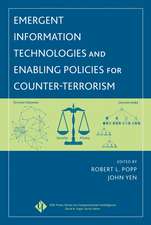Effective Surveillance for Homeland Security: Balancing Technology and Social Issues: Multimedia Computing, Communication and Intelligence
Editat de Francesco Flammini, Roberto Setola, Giorgio Franceschettien Limba Engleză Hardback – 10 iun 2013
Addressing both advanced surveillance technologies and the related socio-ethical issues, the book consists of 21 chapters written by international experts from the various sectors of homeland security. Part I, Surveillance and Society, focuses on the societal dimension of surveillance—stressing the importance of societal acceptability as a precondition to any surveillance system.
Part II, Physical and Cyber Surveillance, presents advanced technologies for surveillance. It considers developing technologies that are part of a framework whose aim is to move from a simple collection and storage of information toward proactive systems that are able to fuse several information sources to detect relevant events in their early incipient phase.
Part III, Technologies for Homeland Security, considers relevant applications of surveillance systems in the framework of homeland security. It presents real-world case studies of how innovative technologies can be used to effectively improve the security of sensitive areas without violating the rights of the people involved.
Examining cutting-edge research topics, the book provides you with a comprehensive understanding of the technological, legislative, organizational, and management issues related to surveillance. With a specific focus on privacy, it presents innovative solutions to many of the issues that remain in the quest to balance security with the preservation of privacy that society demands.
| Toate formatele și edițiile | Preț | Express |
|---|---|---|
| Paperback (1) | 390.37 lei 6-8 săpt. | |
| CRC Press – 16 noi 2016 | 390.37 lei 6-8 săpt. | |
| Hardback (1) | 1189.63 lei 6-8 săpt. | |
| CRC Press – 10 iun 2013 | 1189.63 lei 6-8 săpt. |
Preț: 1189.63 lei
Preț vechi: 1487.04 lei
-20% Nou
Puncte Express: 1784
Preț estimativ în valută:
227.65€ • 235.20$ • 189.37£
227.65€ • 235.20$ • 189.37£
Carte tipărită la comandă
Livrare economică 19 martie-02 aprilie
Preluare comenzi: 021 569.72.76
Specificații
ISBN-13: 9781439883242
ISBN-10: 1439883246
Pagini: 648
Ilustrații: 263 b/w images, 28 tables and 211 Equation lines
Dimensiuni: 178 x 254 x 36 mm
Greutate: 1.29 kg
Ediția:New.
Editura: CRC Press
Colecția Chapman and Hall/CRC
Seria Multimedia Computing, Communication and Intelligence
ISBN-10: 1439883246
Pagini: 648
Ilustrații: 263 b/w images, 28 tables and 211 Equation lines
Dimensiuni: 178 x 254 x 36 mm
Greutate: 1.29 kg
Ediția:New.
Editura: CRC Press
Colecția Chapman and Hall/CRC
Seria Multimedia Computing, Communication and Intelligence
Public țintă
Academic and Professional Practice & DevelopmentCuprins
Surveillance and Society. Physical and Cyber Surveillance. Technologies for Homeland Security.
Recenzii
The objective of this book entitled Effective Surveillance for Homeland Security: Balancing Technology and Social Issues, edited by Francesco Flammini, Roberto Setola, and Giorgio Franceschetti is to discuss the various technological aspects related to homeland security solutions. ... focuses on privacy and other related social issues, which are of conflicting interests with the surveillance operations necessary for the working of homeland security solutions.
—Jaydip Sen, Senior Scientist, Tata Consultancy Services Ltd.
—Jaydip Sen, Senior Scientist, Tata Consultancy Services Ltd.
Notă biografică
Francesco Flammini received, with honors, his laurea (2003) and doctorate (2006) degrees in computer engineering from the University Federico II of Naples. Since October 2003, he has worked in Ansaldo STS (Finmeccanica) on the safety and security of rail-based transportation infrastructures. He has taught computer science and software engineering as an adjunct professor at the University of Naples, as well as seminars on computer dependability and critical infrastructure protection in postdegree courses on homeland security. He has coauthored several books and more than 50 scientific papers published in international journals and conference proceedings.
He has served as the chairman, a PC member, and an editor for several international conferences and journals. He is a senior member of the IEEE, an ACM Distinguished Speaker, and the vicechair of the IEEE Computer Society Italy Chapter. He is also a member of the European Workshop on Industrial Computer Systems Reliability, Safety and Security (EWICS TC7), FME (Formal Methods Europe), ERCIM WG on Formal Methods for Industrial Critical Systems (FMICS), ESRA TC on Operational Safety & Security of Interconnected Critical Infrastructures, and IEEE SMC TC on Homeland Security.Roberto Setola obtained his master of science in electronic engineering (1992) and PhD in electronic engineering and computer science (1996) from the University of Naples Federico II. He currently serves as a professor of automatic control at University CAMPUS BioMedico and head of the COSERITY Lab (Complex Systems & Security Lab). He is also the director of the master's program for Homeland security, systems and methods and tools for security and crisis management. Formerly a member of the Italian Prime Minister's Office (1999-2004), Setola was the coordinator of the working group on critical information infrastructure protection established by the Italian Prime Minister (2003-2004), a
He has served as the chairman, a PC member, and an editor for several international conferences and journals. He is a senior member of the IEEE, an ACM Distinguished Speaker, and the vicechair of the IEEE Computer Society Italy Chapter. He is also a member of the European Workshop on Industrial Computer Systems Reliability, Safety and Security (EWICS TC7), FME (Formal Methods Europe), ERCIM WG on Formal Methods for Industrial Critical Systems (FMICS), ESRA TC on Operational Safety & Security of Interconnected Critical Infrastructures, and IEEE SMC TC on Homeland Security.Roberto Setola obtained his master of science in electronic engineering (1992) and PhD in electronic engineering and computer science (1996) from the University of Naples Federico II. He currently serves as a professor of automatic control at University CAMPUS BioMedico and head of the COSERITY Lab (Complex Systems & Security Lab). He is also the director of the master's program for Homeland security, systems and methods and tools for security and crisis management. Formerly a member of the Italian Prime Minister's Office (1999-2004), Setola was the coordinator of the working group on critical information infrastructure protection established by the Italian Prime Minister (2003-2004), a
Descriere
Since the September 11th attacks, the scientific and engineering communities have been called upon to help the world respond to security challenges. This volume focuses on multidisciplinary problem analysis and systems engineering approaches to security. It presents a comprehensive survey of state-of-the-art methods for the surveillance and protection of citizens and critical infrastructure against both natural and deliberate threats. The first section analyzes technical issues related to surveillance. Next, the book examines legislative, organization, and management issues with a specific emphasis on privacy concerns. Finally, the contributors discuss innovative solutions and new research topics garnering heightened attention.

























